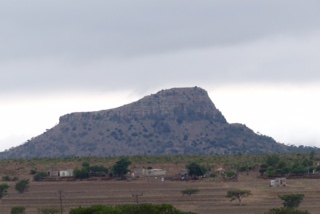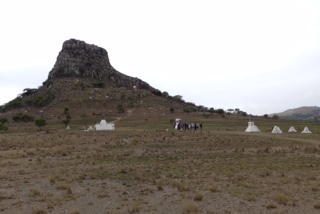History 2 - Isandlwana and Rorke's Drift.

VulcanSpirit
Richard & Alison Brunstrom
Tue 8 Dec 2015 20:55
Here is Rorke's Drift:
A drift is a ford, in this case across the Buffolo River which runs in the valley between the road and the hills. The ford was in the trees to the right. The river was the boundary between British Natal to the south and Zululand to the north. Jim Rorke was an Irish trader, but by 1879 his trading post had become a mission station though still known to the Zulu as kwaJim - Jim's place. The mission station is more or less in the gap to the right of the left hand hill.
The British annexed the Boer Republic of Natalia in 1843. Most Boers migrated further north to get away. Britain was considering a plan like that successfully used to create the Canadian Confederation in 1867, and in 1877 one Sir Henry Bartle Frere was sent out to implement it. He had been promised the Governor-Generalship if successful, but the independent Zulu kingdom and the Boer Republics were in the way. Bartle Frere set about engineering a war with the Zulus, without the knowledge of the British government (who were in fact keen to avoid war in Africa as the Army was fully stretched elsewhere). Bartle Frere concocted a humiliating ultimatum to the Zulu King Cetshwayo knowing that he could not comply with it, resulting in Bartle Frere ordering his army commander Lord Chelmsford to invade Zululand and thus initiating the Anglo-Zulu war, against the express wishes of the British government.
Chelmsford entered Zululand via Rorke's Drift and camped for the night of 21 January 1879 under the hill of Isandlwana, seen here in the distance:
Ironically given what was to follow the British soldiers thought the hill was a good omen as its shape resembled the Sphinx depicted on the uniform of the 24th Regiment of Foot who were a major part of the invading force. Chelmsford camped for the night on the shoulder to the right of the hill in the picture above. He failed to follow his own written field regulations, in that he did not entrench, nor even create a laager with his wagons. The following morning he divided his force in two and set off with the stronger part in search of the Zulu. Chelmsford had also failed to out scouts out far enough, and was entirely unaware of the developing disaster.
Left in charge at the camp was a Brevet Lt Col. Pulleine RE, an officer with no combat experience. The Zulus attacked in strength on the morning of the 22nd, Pulleine deployed badly, and the camp was overrun. About 1700 British troops died, mostly where they stood and fought. The Zulus were mightily impressed that none turned and ran. Chelmsford ignored repeated calls for help, not able to believe that a camp defended by over 1000 highly experienced soldiers armed with the very latest rifles could be threatened by an Iron Age tribe.
Chelmsford eventually returned that night, still unable to credit what had happened. He prevented a search of the battlefield (indeed the British were not subsequently able to return to the site until July) so no British dead were even buried. Chelmsford retreated back across the Buffalo in panic, relieving Rorke's Drift as he did so.
Here is the ridge, the campsite:
The site is vast (only a very small portion is visible here) due to Pulleine's stupid deployment, and there are small white cairns visible all over the surrounding countryside. These are where small knots of British troops fought and died, what was left of their remains eventually buried in mass graves marked only by these cairns. According to the Zulus the last survivor was holed up in a cave just visible in the cliff above the main monument where he acted as a very efficient sniper. The number of Zulu dead is unknown as the Zulu did not count death in the same way, but is nowadays estimated at at least 1000. The protected site, left almost exactly as it was in 1879,is an extremely poignant reminder of the consequences of the thoroughly immoral actions of Bartle Frere (who of course did not give up his own life here, although he was removed from his post in disgrace).
A small group of British soldiers from the 24th had been left to defend Rorke's Drift mission station. They were attacked immediately after the massacre at Isandlwana by about 4000 Zulus who had defied their King's edict not to cross the Buffalo (he was trying to demonstrate to the British, with whom he had wanted only peace, that he had no designs on Natal). The mission station was heroically defended over ten hours of gruelling combat with only 17 killed against about 500 Zulus, due to the outstanding leadership of Lieutenants Chard and Bromhead. 11 VCs were won, plus numerous other awards for valour.
Here are the two memorials at the Drift, the Zulu one being particularly moving, with the a leopard (the Zulu Royal animal) lying on the piled shields of the fallen warriors and a kraal (the fence around a Zulu village) in the background:
The U.K. Government was utterly humiliated. Of course a punitive expedition had to be launched to preserve Britain's reputation in the world, and it was. The Zulu army was destroyed, exactly as Cetswayo had feared, and the kingdom split up. Consequent civil war resulted in annexation as British Zululand in 1888 and the end of Zulu independence for ever.
Chelmsford who had redeemed himself slightly by winning the war never received another operational command and was entirely shunned by the government.
A macabre consequence of the battle of Isandlwana was the swift disappearance of beards from the British army, where they had previously been very popular. The Zulus were extremely impressed with the soldiers' bravery which they attributed to their beards. In order to inherit their bravery they decided to hack off the bearded lower jaws of the dead soldiers (some probably before they were dead) to use in magic potions. When the news spread, beards disappeared almost overnight.
Sent from my iPad




